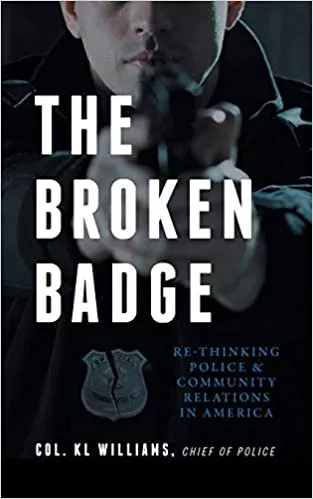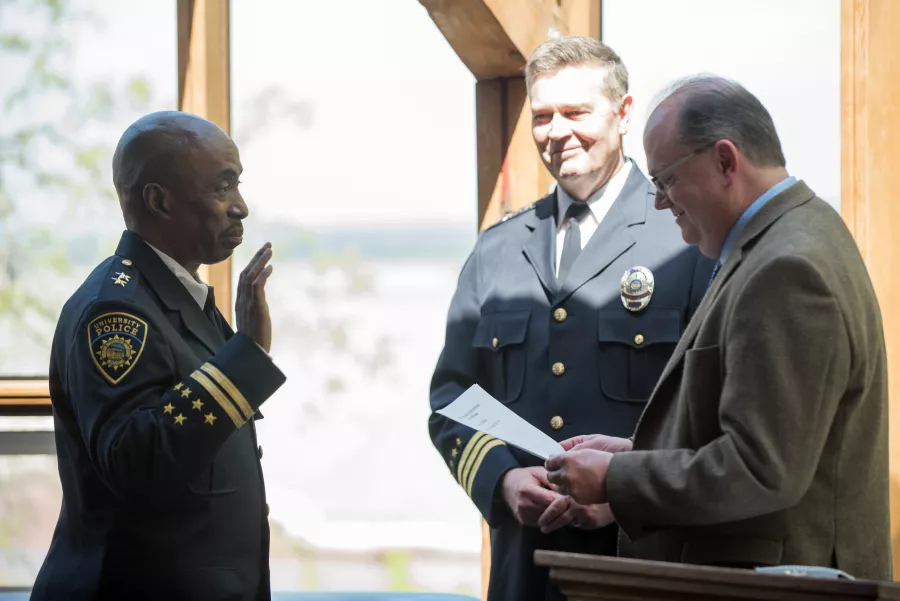Content warning: Includes descriptions of racial violence and sexual assault.
Thirty years ago, Western’s Assistant Director of Public Safety Keith Williams put on a police uniform for the first time. And today as the nation attempts to come to grips with issues of racial injustice and police brutality, Window magazine sat down to talk to Williams about life as a Black man at a time when so many people of color view the uniform as a tool of oppression. We also asked how he feels his chosen profession must evolve to gain the trust of communities of color.
As a Black man as well as a police officer, you’re at the intersection of a lot of intense discussions in our society after the death of George Floyd. Have you ever felt any internal conflict between your race and your chosen profession? If so, how did you process it; and if not, how have you been able to keep them separate?
As I navigate over 30 years as a law enforcement officer, the question of how do I address being a cop and a Black man has often been asked. I have been called a “sellout” and an “agent of the man” by many, and other terms that are not as kind.
After the death of George Floyd I immediately reflected back to the death of Mike Brown in Ferguson, Missouri. Even though each of these incidents is different, one of the similarities is that both of these men were Black and unarmed. I was chief of police in nearby Kinloch, Missouri, when the Mike Brown incident occurred, and I had an opportunity to witness first-hand when both sides of the equation square up against two difficult areas to address: police abuse and police reform.
Then when I observed the George Floyd situation unfold and the officer keeping his knee on Mr. Floyd’s neck for almost nine minutes, my first thought was about the old slave discipline technique called “buck breaking.” Buck breaking was a process where the largest, strongest Black male was brought forward, stripped of his clothing, tied to the ground or over a tree stump then brutally raped by the master in front of the slave’s wife, children, and other slaves. This was to let the other slaves know the fate that waited for them if they did not conform and do whatever the master said. George Floyd, with that officer’s knee on his neck, looked to be a reminder to all that watched what would be their outcome if they did not do what they were told.
Your 2018 book, "The Broken Badge: Rethinking Police and Community Relations in America," aims to shed light on how a toxic and insular police culture has led in many cases to an erosion of trust between the police and the citizens they serve. What has the feedback been like from fellow officers about your book?
Feedback from colleagues has been mixed. Some officers stand in solidarity with the fact that police work as we know it must change. Officers must be held accountable and the evolution of police culture must occur, or we will never truly be able to move forward. Other officers believe that the business of police work must stay behind closed doors and only police officers can monitor and find solutions that are needed. “Stop putting our dirty laundry out for the public to see” was one comment told to me by another officer.
How does this inward-focused police culture—one of silence about procedures, disciplinary action, and the "thin blue line" become especially damaging to communities of color, whose race is probably not reflected in that police force?
Where there is an inward-focused police culture often you will find a community that has very little trust for those police officers that work in their area. When that thin blue line looks to perform their duty without any public oversight, there are opportunities for many negative police behaviors to go unchecked. When a police culture values a code of silence over the truth, certainly you can and will see abuse.
I like the symbolic figure of Lady Justice as an example of doing things the right way. Lady Justice is blindfolded because as officers of the law we should only be interested in the truth. She has the scales as a means to balance the evidence. The sword is known by most police officers because this is the symbol for justice or discipline toward arrested subjects.
In policing, the goal should be to have the police force reflect the communities we serve. Diversity is important both for the community to see and also for the officers to be vigilant when police abuse is observed. In communities of color, citizens are standing up for justice and accountability with the hope of creating a system that is fair and equitable and representative of the values that make America great.
What made you decide to want to become a police officer?
My primary reason was due to having four separate occasions when the police drew their weapons on me for no apparent reason as a youth—other than me wanting to exist as a Black male. I knew subconsciously that I could not change the abuse done by police officers from the outside; I was going to have to change things from the inside.
In your opinion, as protesters around the country call for police reform, what is the most important, meaningful first step that can be taken to heal the rift between so many communities and their police?
Two of the areas that the public must be assured of when looking at police actions and police behavior are accountability and transparency. All too often, the public sees officers doing their duty in poor communities of color with excessive violence and disdain and communities of affluence with white populations are policed in a more positive and productive way.
Some officers have stated that Black males, in particular, are to be feared as “beasts,” and the maximum amount of force and control should be applied to them. Another officer even said that Black males should be shot down like rabid dogs. I have spoken with officers throughout the years who have told me that Black people are genetically predisposed to be criminals and they must do all they can to control that behavior. As a police officer, if I believe the person I am engaging is a violent criminal then certainly I am going to approach that individual much differently than if I believe the person in front of me is a peaceful, law-abiding citizen.
When the protests and riots in and near Ferguson, Missouri, started in 2014 after the death of Michael Brown, you were the newly promoted chief of police in nearby Kinloch, and your home was heavily damaged in the riots after Brown’s death. At the time, how did you juggle your role as a police officer, the damage to your home, and any feelings of empathy you had towards the community and what they were going through?
Oftentimes people forget that police officers are not born into that uniform. I have been Black all my life and as such, in my youth prior to joining the police force, my perspective of the police was typically one of oppression and injustice. I do understand the anger and frustration people of color feel towards law enforcement. I have had people call the police on me for no reason, police point their guns at me for no reason, police call me racial epithets for no reason and of course I am far from being alone in this matter.
During the Ferguson riots, my residential garage was set on fire even though I lived 10 miles from Ferguson. The anger is all too real, and this type of scenario continues to play out over and over again.
The Rev. Martin Luther King, Jr. called riots “the voice of the unheard,” and from Watts to Detroit to Los Angeles to Ferguson and now to cities across America, a collective rage against systemic injustice and police brutality is erupting. Does anything feel different to you about the current protests than it did following the previous events?
After the death of George Floyd and the resulting protest with Black Lives Matter, front and center, there does seem to be a different feeling in the air. Having witnessed far too many police-related shootings of unarmed Black males and the subsequent arrest of white subjects who had committed mass murder apprehended with minimal force, and even offered food and water after the incident, makes you question the police officers’ ethics and professionalism.
What do you think policing, as a profession and as a practice, will look like 20 years from now, specifically as a result of the current social unrest?
In 20 years I believe we will have seen a revolution in the way policing is done in America. Those two specific concepts I mentioned earlier will become more important than ever—accountability and transparency, as it relates to the officers’ duty and the way investigations are conducted.
One of the primary areas that I believe will change is the evolution of police culture. I believe many of the current cultural aspects of police work will slowly fade away because of the reality that certain current all-too-common behaviors make it difficult for the police community to move forward. Circling the wagons when a police officer’s behavior or actions are called into question is one example. Officers need to immediately step in when they witness police abuse or misconduct, and this will need to be a standard practice. Departments also have to stop the practice of demoting, transferring, or even terminating an officer’s employment when that officer reports another officer for violating department police policy, law, or the constitution.
If we can move forward on those two key issues – accountability and transparency—policing 20 years from now will have experienced a huge leap forward, especially for communities of color.


